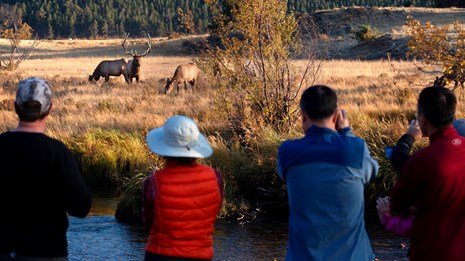Introduction
Captivated by the call of the wild? Wildlife watching offers an unparalleled opportunity to connect with nature, observe fascinating animals in their natural habitats, and cultivate a deeper appreciation for our planet’s biodiversity. However, it’s crucial to approach this activity with respect and mindfulness. This guide offers essential guidelines for respectful wildlife observation, ensuring that your experiences are both enjoyable and eco-friendly.
Why Respectful Wildlife Watching Matters
Wildlife watching isn’t just about spotting animals; it’s about understanding and respecting their roles in the ecosystem. By observing wildlife responsibly, we minimize our impact on their habitats and behaviors. Respectful observation ensures that future generations can also enjoy these natural wonders.
The Impact of Human Presence
Human presence can significantly affect animal behavior. Loud noises, sudden movements, and even our scents can disrupt their routines, causing stress or even leading them to abandon their habitats. Understanding this impact helps us adjust our behaviors to be less intrusive.
Conservation Efforts
Respectful wildlife watching supports conservation efforts by promoting awareness and appreciation. When people see the beauty and complexity of natural ecosystems firsthand, they’re more likely to support initiatives that protect these environments.
Personal Enrichment
Beyond ecological benefits, respectful wildlife watching enriches personal experiences. Observing animals in their natural setting, undisturbed, provides a sense of peace and connection that’s hard to find elsewhere.
Preparing for Your Wildlife Watching Adventure
Preparation is key to a successful and respectful wildlife watching experience. Here are some tips to get you started.
Research Your Destination
Before heading out, research your destination. Understand the types of wildlife you might encounter, their behaviors, and the best times for observation. This knowledge helps you anticipate their actions and reduces the risk of disturbing them.
Gear and Supplies
Pack accordingly. Binoculars, cameras with zoom lenses, and appropriate clothing are essential. Remember to bring supplies like water, snacks, and a first-aid kit, but avoid carrying items that may produce noise or odors that could attract or repel animals.
Understanding Local Regulations
Many wildlife areas have specific regulations to protect both visitors and animals. Familiarize yourself with these rules and follow them strictly. This might include staying on designated paths, maintaining a safe distance, and avoiding feeding the animals.
Best Practices for Respectful Wildlife Observation
Respectful wildlife watching involves both mindset and practice. Here are key guidelines to follow.
Maintain a Safe Distance
Keeping a safe distance from animals is crucial. Use binoculars or zoom lenses to get a closer look without encroaching on their space. This reduces stress on the animals and keeps you safe from potential dangers.
Silence is Golden
Noise can startle animals, causing them to flee or exhibit stress behaviors. Speak softly, turn off your phone, and move slowly. By minimizing your noise, you create a more natural environment for wildlife and a more immersive experience for yourself.
Leave No Trace
The principle of “Leave No Trace” is vital in wildlife watching. Take all your trash with you, avoid picking plants, and refrain from altering the environment in any way. Your goal is to leave the habitat as you found it, if not better.
Ethical Photography Tips
Photography is a common part of wildlife watching. Here’s how to do it ethically.
Use the Right Equipment
A good zoom lens is your best friend. It allows you to take close-up shots without getting too close to the animals. Remember, their safety and comfort come first.
Patience is Key
The best wildlife photos often come after long periods of waiting quietly. Patience not only increases your chances of capturing stunning images but also ensures that you don’t disturb the animals by rushing or making sudden movements.
Avoid Flash Photography
Flash can startle animals and disrupt their natural behaviors. Use natural light whenever possible, and learn to adjust your camera settings to accommodate low-light conditions.
Engaging with Local Communities
Local communities often have deep-rooted connections with their surrounding wildlife. Engaging with them can enrich your experience and support conservation efforts.
Learn from Locals
Locals can offer invaluable insights into animal behavior and the best spots for observation. Their knowledge can enhance your understanding and appreciation of the wildlife around you.
Support Local Businesses
Consider hiring local guides or purchasing supplies from local businesses. This not only supports the community but also invests in the preservation of the area. Many resorts, like the Nordic Valley Ski Resort, offer guided tours that balance adventure with conservation.
Participate in Conservation Programs
Many regions offer volunteer programs or conservation initiatives. Participating in these can give you a more hands-on understanding of local wildlife and contribute positively to the community and environment.
Respectful wildlife watching is a rewarding way to connect with nature. By following these guidelines, you ensure that your encounters are both enjoyable and sustainable.
Whether you’re a local resident, a business owner, or an eco-tourist, these practices will help you make the most of your wildlife adventures while protecting the magnificent creatures you observe. Ready to take the next step?
Plan your visit, pack your gear, and immerse yourself in the wonders of the wild. And if you’re looking for a unique guided experience, consider booking a tour at the Nordic Valley Ski Resort for a blend of adventure and tranquility.












